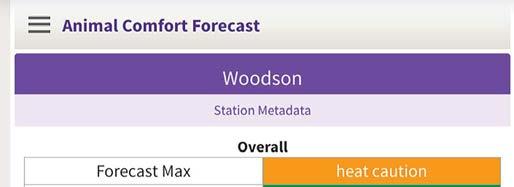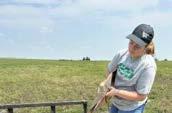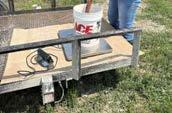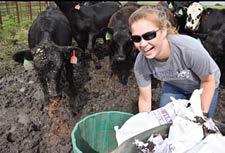



































ABBREVIATIONS











































Joint efforts involving Kansas State University Foundation, KSU College of Agriculture and the Woodson County Extension Service have turned a 625- acre pasture gift into an agricultural research project.
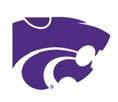
TheBressnerRangeProjectinvolvesadjacenthalfsectionsofnativegrassnearYatesCenter.TheKSU Foundationreceivedthislandvaluedat $128,000 through Willie J. Bressner’s estate distributionin1989.
This property was donated without restrictions but, Mr. Bressner requested that it be utilized as an experimental project to study the preservation anduseofnativegrasses.
BillBressnerspenthisentirelifeonthefarmwhere he was born. His love for the land and Hereford cattlewasquiteobvious.Hewasverycarefulnotto overgrazehispasturesandhiscattleneverhearda harshwordnorsawawhipfromhim.Hiseducation waslimitedtotheeighthgrade,buthedeveloped a great interest in grass management. For those whoknewMr.Bressner, he was anextremelyearly riser and went to bed very early also. It is through his generous gift to KSU that research has been conductedsince1990onthispasture.
Thisresearchpasturewouldhaveneverhappened without the support of his attorney Clyde Hill. Mr. Hill was not only an attorney, but was elected to State HouseofRepresentativesinthemid-50’s.He retired as chairman of theHouseWays and Means Committeein1974. Unfortunately, Mr. Hill passedawaypriortoour rst eldday.Hiswisdom andcommonsenseistrulymissed.
One group that has helped weigh and tag cattle or helped with the annual burning included a lot of my co-workers in Extension and many of them have retired. Those who have retired or changed jobs include: Chris Petty-Bourbon Co., Darren
Hibdon-FranklinCo.,MarvinFausett-SoutheastArea Economist, Dave Kehler-Butler Co., Jeff DavidsonGreenwood Co., Jim Mengarelli Crawford Co., Josh Coltrain-Crawford Co., Keith Martin-Labette Co., Mike Holder-Chase Co., Dr. Karl Harbour-Southeast AreaLivestockSpecialist,WarrenBell-CoffeyCo.,Dr. Doug Shoup- Southeast Area Crop Specialist and Dr.FrankBrazle-SoutheastAreaLivestockSpecialist, who’s research knowledge has been extremely important to this committee. Those that are still workingas agentsinclude:Darl Henson-CoffeyCo., Rob Schaub and Ryan Schaub both from Frontier District, Ben Sims - Greenwood Co., and Hunter Nickell and Chad Guthrie-Southwind Extension District. I apologize to anyone that I left off of my list. When we are busy working I don’t take time to write names down, and my memory is getting shorterasIgetolder!
My brother, Eldon and nephew Scot Lanham also have helped me on many of these projects. Others who have helped: Jared McVey-Woodson County NoxiousWeedDepartment,WoodsonCountyRural Fire Department, Terry Wells and his crew, John Johnson and crew fromWildlife and Parks, Michael Old and his crew, and Dennis Klick-deceased NoxiousWeedDirector.
Dr. Walt Fick has been doing the range inventories formanyyears.
Herschel George is the man responsible for most of the water projects that we have done on this pasture over the last several years. He keeps the solarpanelsandwaterpumpsoperating.
People that have furnished cattle for this pasture since 1989 include: Dick Pringle-deceased, Kimbell Ranch, Edgar Beecher-deceased, Hay-Capital Feeders, Eldon & Scot Lanham, Kenneth Laymond, Ronnie Reynolds, Eric Karmann, Michael Old, Lee Robbins and the last few years Hy-Plains Feedyard. Weappreciatetheirgreatsupport.
Without Jaymelynn Farney these reports would just be paper to look at. She is the person who interprets the numbers to give us the nal results. Did the spice mineral work? Did it make money for the additional investment? Did early March burning cost producers in cattle gains?This iswhy

½vs¾seasongrazingwithstockers (replicated9years)
-FieldDay
FieldDay
Grazingduringsummerandfallgrazing withstockers(replicated5years)
FieldDay
Patchburngrazing(replicated7years)

FieldDay
Grazingsheepafterdoublestock grazingfor control(replicated4 years)
Grazingimplantsevaluation
Essentialoilsforcattlegainsanduseas ycontrol
Timingofburningandaddition ofessentialoilsforcattlegains,pasture compositionchanges,and ypopulation control(replicated5years)
wedotheresearchforatleast5years,tohelpeven out the major weather patterns. If you stop with oneyearofdata,itisonlyare ectionsofthatyears information.Researchtakestimeandreplications. Kansas State University Foundation is the land owner and we greatly appreciate the opportunity toconductresearchonthispasture.


• Ron Wells, rancher-cattlemen, who had an untimely accident that cut his life extremely short. He was always searching for additional knowledge,especiallyaboutnativegrass.Ron’s son,Terryiscurrentlyonthecommittee.
• Albert (Speck) Mann, a true lover of Hereford cattle, always wanted to do research involving cows.
• Altis Ferree, jack of all trades was a livestock producer, hay producer, pipe and water tanks salesman as well as a good crop farmer. Grandson,MichaelOldisnowamemberonthe Bressnercommittee.

Their knowledge and stories of the cattle industry in Woodson County was educational and always highlyentertaining!
Professor Gary Kilgore, retired Southeast Area Extension Specialist, passed on June 19, 2023. Gary spent many hours doing range inventories and was instrumental in designing the original pasture layout. He was very helpful in keeping our committee grounded on the research we were doing on this pasture. Gary’s body was wearing out and he was con ned to a wheel chair for his transportation, but his mind was still extremely sharp. He was determined that he was going to be at the Field Day in September to enjoy “his people”. His knowledge and wisdom can never be replaced because of his practicality and his ability tocommunicatetoallpeople.


Essentialoils/spiceshavebeenofferedasapotential method to controlinsectsincattle(Showler,2017; Massariol et al., 2009), alter rumen microbial population (Elcoso et al., 2019), and replace feed antibiotics, all of which may improve production responses in beef as well as dairy cattle. In feedlot studies, cattle consuming a blend of essential oils had similar average daily gain, nal body weight, gain to feed ratios, and carcass characteristics as steersfedmonensinwithorwithouttylosin(Araujo et al., 2019). Grazing stocker cattle on cool-season annual grass pasture or summer pasture did not showimprovementsingainswhencattlereceived a cinnamon and garlic essential oil product by either free-choice or hand-feeding (Beck et al., 2017). However, other studies at Kansas State Universityhavefoundthatfeedingsupplementsof spices in mineral have increased gain in growing cattleongrass(Farney,2020a;Farney,2020b).
BurningpastureinAprilresultsinabout20pounds moregainingrazingcattlethanburningapasture in March (Owensby, 2010). Smoke management plans are important for the state of Kansas as high smoke production in April creates smoky conditions that drift to large metropolitan areas. If weight gains and plant population changes are not too different when burning in March insteadofApril,earlierburningwouldprovidethe opportunity to develop a smoke management plan that allows for an increased burning season todiluteasinglemonth’ssmoke.
The overall objective of this study is to evaluate management practices that may impact stocker steer gains on a 90-day double-stocking grazing systemintallgrassnativerange.Speci cobjectives are to evaluate the time of burning, and the inclusion of spices in the mineral supplement, and to determine whether the effects of both treatmentsareadditive.
The study was conducted at the Bressner Research unit in Yates Center, KS. The unit consists of eight pastures on 625 acres of tallgrass native prairie. Two management strategies were evaluated to determine effects on stocker steer gains in a 2 × 2 factorial arrangement. The two management strategies were timing of pasture burning and free-choice mineral supplementation. Within each management strategy there were two treatments being evaluated, thus a total of four treatments were applied to the cattle at the unit. The pasture burning management strategies evaluated were burninginMarchorburninginApril.Table1shows thespeci csofeachyearfortheresearchproject.
Spice mineral with similar base as control mineral with the addition of 3 pounds per ton garlic oil and 18 pounds per ton of Solace (Wildcat Feeds Inc., Topeka, KS) that replaced dried distillers grains and limestone in control mineral.
Nuplex Mg/K (Nutech Biosciences Inc., Oneida, NY) contributed 25% of the magnesium in the minerals.
Nuplex 3-chelate blend (Nutech Biosciences Inc., Oneida, NY) contributed 25% of the copper, zinc, and manganese of the total trace mineral supplied in the minerals.
The free-choice mineral supplementation strategies consisted of: (1) free-choice complete mineral (CON) where 25% of magnesium (Nuplex Mg/K, Nutech Biosciences, Inc., Oneida, NY), copper, zinc, and manganese came from chelated organic sources (Nuplex Chelate-3 blend, Nutech Biosciences); and (2) the same base mineral with the addition of spices (SPICE).The spices included were powdered forms of oils from garlic and the product Solace (proprietary blend of four spices; WildcatFeedsInc.,Topeka,KS).Themineralanalysis islistedinTable2.Themineralswereformulatedfor a 4 ounce/head/day intake and were offered free choice.Everyweek,125%ofthatweek’sformulated mineral consumption for each pasture was placed into feeders and weighed. Any remaining mineral fromthepreviousweekwasalsoweighed.
Twohundredeighty-onesteerseachyear(average initial weight 566 lb) were weighed individually on in late April and assigned to pasture randomly based on order through the chute. Cattle were weighedattheendofthestudyinmid-Julyfor8390daysofgrazing.
Weekly, 33% of the steers in each pasture were photographed with a Nikon digital camera with a 300 mm zoom lens, with the photographer’s back tothesun.Thesteerswerephotographedwiththeir entireside llingtheview nder.Thenphotoswere processedwithImageJand iescounted(Figure1). Additionally,haircoatscorewasrecordedfromthe photos with a score of 1–5, where a 1 was a 100% slick haired animal; 2 had 25% of body with long hair;3 has 50% of body coveredin long hair;4 has 75% of body covered in long hair; and 5 is 100% long haired. Data collected included number of iesandhaircoatscoresforeachweek.
Averaged over the 5 years, the April-Spice treatment and the March-Control treatments had the greatest nal weight, ADG, and grazing gains (Table 3). The April burned pastures where cattle grazedthecontrol mineralhadthelowestgains of allthecombinationoftreatments. However,within year, there was quite a bit of variability of which combinationoftreatmentsresultedinthegreatest ADG (Figure 2). Outside of 2020, within burn month,theSpicefedsteershadanADGadvantage.
Theyear-to-yeardifferencesareexplainedtosome degreebymaindifferenceeffectsduetoburndate and subsequent moisture patterns. In 2019, April burnedpasturesresultedinthegreaterADG;in2022 and2023theMarchburnpastureshadgreaterADG; 2021tendedtohavegreaterADGinMarchburned pastures; and in 2020 no differences. In general, when there was early spring and summer rains,

followed by extremely dry condition there was an advantage to March burning. Forgrazing seasons where the precipitation continued through the grazing period, there was no differences between in ADG. It was snowing at turnout in 2021 and overall, there was lower gains during that grazing year.
The spice mineral, averaged over the 5 years has resulted in 0.10 poundsincrease in ADG (P = 0.03; Table 5) and that has been fairly consistent (2021 was the exception - overall low precipitation year and snowing at turnout, thus less overall forage produced).
Flies increased through the summer (P < 0.001). There were no differences in y numbers based onwhethercattleconsumedthemineralorbased on pasture burn date (P> 0.10). There were some interactions of week x burn that were detected
(Figure 3). Overall, y counts were greater towards the end of the grazing season with March burned pasturesascomparedtoAprilburning.
Thesteers onthe Spicemineral overall were slicker haired(hairscoreof2.5forSpiceand2.7forControl). By3weeksonthemineraltheSpicesteershadshed fasterthanthoseonControlmineral.
a,b,c Different superscripts within year indicate differences in treatment (P <0.05)



- MAR-CON: March burn with Control mineral
- MAR-SPICE: March burn and Spice mineral
-APR-CON: April burn and Control Mineral
-APR-SPICE: April burn and Spice mineral
Weather plays a large role in how stocker steers perform, and with the wide range of weather patterns, there was no overall difference in cattle gains when burning in March or in April. This can be bene cial when looking at managing for statewidesmokeloads.
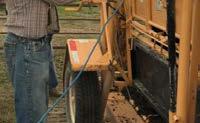
TheSpicemineralresultsin0.10poundsmoreADG in a double stock tallgrass native range system. There have been two other studies conducted on grazing calves (one on Bromegrass and one on tallgrass native range) and similarly have found a minimum of 0.10 lb increase in ADG. Over the 5 years of this study, the Spice/essential oil blend used cost $0.02/head/day in a 4 ounce mineral (consumptionofmineralswereoverall18%higher, Figure 5). The true average cost of the minerals was $0.0236 per head per day. Over a 90 day grazing season that is an increased cost of $2.12/ steer to feed the essential oils over plain mineral. OnaveragetheSpicefedsteersgained10pounds
more over the 90 period. Using average feeder priceoverthestudyperiod(2019-2023)of$152.94/ cwt the Spice steers sold for $15.29 more at sale. When subtracting the additional cost of the Spice in the mineral, the Spice mineral steers netted $13.17more.





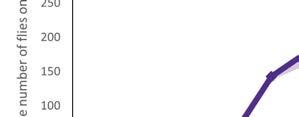
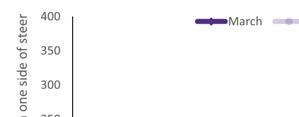







Unfortunately, the essential oils fed and the amounts of the essential oils did not work as a method to control horn y populations. Based on the published literature, ingestion of the essential oilshavenotworkedtokeephorn iesoffofcattle. When using the essential oils as a spray, they do keepcattlefreerof ies.
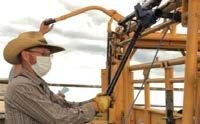

To compare vegetation response to MarchandAprilburning.
The study was conducted on the Bressner pastures from 2019 to 2023. Pastures 1-4wereburnedeachyear,withanaveragedateof March 16. Pastures 5-8 were burned in each year, withanaveragedateofApril13. Burningwasconducted prior to stocking with 550-pound animals frommid-Apriltomid-Julyusinganintensiveearly stockingsystem(90days)allowing2acres/head. Amodi edstep-pointmethodwasusedtocollect 2or3,100-pointtransectsperpasture.Thestarting point of each transect was determined using GPS coordinates with about 10 feet between points. At each point, hits, closest plants, and the nearest forb or woody plant was recorded after a hit on a grass or the closest plant was a grass. Step-point sampling was conducted in the late summer/fall afterthegrazingperiod.
Botanicalcompositionvariedfromyearto yearinboththeMarch(Table1)andApril(Table2) burnedpastures.Priortostartingtheburningdate

study,thebig4grasses(bigbluestem,Indiangrass, switchgrass, and little bluestem) contributed over 47% of the basal cover in the pastures. The combined composition of these key species declined toabout34%in2020whenannualgrassesreached peak numbers. Total forbs and Sericea lespedeza reached maximum levels in 2021 in both March (Table1)andApril(Table2)burnedpastures.
Over the course of the study, few differences oc-

curredwhencomparingplantcompositionchange between the March and April burning dates (Table 3). Switchgrass tended to decline with March burning(p<0.08)andsedgetendedtodeclinewith April burning p<0.12). Total forbs are increasing similarlywithbothburningregimes.
FiveyearsofburninginMarchor April changed plant composition very little at the Bressnerpastures.
ManyFlintHillsstockeroperationsutilizeIntensive Early Stocking management. This management scheme grazes native-grass pastures with stocker cattle during the rst months of summer (late April to mid-July) and takes advantage of high quality forage growth. After cattle are removed from pastures, the grass plants are allowed to rest, complete their life cycles, and establish carbohydrate reserves. Oftentimes weather conditions will allow abundant plant regrowth during the last half of the summer. During late summer, the plant matures and its nutritive value declines.Manycattleproducerswouldliketograze this low-quality forage if no harm would be done to the desirable pasture grasses or the next year’s cattleperformance.
Typically, the cattle used to graze this dormant native grass would be calves started in the fall, cows, and/or yearlings. Fall grazing has the potentialtoreducetheamountandcostassociated with feeding mechanically harvested forages. However,concernsaboutanimalperformanceand range conditions persist.With these facts in mind, the objective of this study was to determine if fall grazing following intensive early stocking would haveaneffect onthesubsequentsummerstocker cattlegains.
Eight native grass pastures located near Yates Center, Kansas were randomly allotted to treatments. Treatments consisted of: 1)stocker cattle grazed following the guidelines of a normal Intensive Early Stocking program, or 2)stocker cattle grazed following the same guidelines as Treatment 1 plus pastures were grazed in the fall. Theintendedoutcomeoftreatment2wastohave about800lbofforageperacreleftafterfallgrazing forspringpastureburning.Therefore,themethods usedtodeterminestockingrateforfallgrazingon nativegrasswereasfollows:
LbofD.M.ofavailableforage/acre-800lb=lbof foragex.33=(harvestefficiency)=lbofforageto beconsumedbycattle/acre
Stockingrate=acresxlbofforageconsumed+2% ofbodyweightofcattlexdays=numberofcattle/ pasture

Example:80acrepasturewith1,100lbofavailable forageperacretobegrazedby500lbsteersfor60 days(October1toDecember1).
1,100lb-800=300lbx.33=99lbavailable forageforconsumption
Availableforage=80acresx99lb=7,920lb Predictedanimalconsumption=500lbx2%=10 lbx60days=600lb/head Stockingrate=7,920+600=13headper80acres (500lbsteersfor60days)
The fall grazing periods varied from 44 to 67 days and were completed in October and November. Fallgrazingwasaccomplishedinyears2001,2002, 2003,and2004with500to600lbsteersorheifers. Fall-grazing cattle weresupplemented with5 lb of corn gluten feed/head/day. The following spring, each pasture was stocked by predicting the AUM carryingcapacityoftheindividualpastures.
Thepasturesweregrazedwith500to600lbsteers forthesummersof2001,2002,2003,2004, and 2005. For years 2001 to 2004, the 625 acres (8 pastures) were stocked with 313 hd steers (500600lb)andgrazedfromApril22toJuly15(84days) resulting in an average stocking rate of one steer per1.99acres.
During the summer grazing period there was no difference in average daily gain regardless of whether pastures were grazed in the fall of not (Table 1). When steers were supplemented with 5
lbofcornglutenfeedperheadperdayduringthe fallgrazingperiod,thesteersgainedbetween1.36 to 1.44 lb/d (Table 2). It appears from these data that cattle producers can take advantage of fall grazingtoincreasetheproductionofbeefperacre ofpasturewithoutcompromisingnormalsummer animalperformance.
Native grass can be fall grazed (in October and November) following normal half-season grazed pasture (Intensive Early Stocking) when regrowth occurs without negative impact on the following year’s summer animal performance. However, guidelines must be used in determining fall grazingstockingratestoensuredesiredamountof grass so that native grass pastures can be burned inthespring.

Theeffectofanygrazingsystemonplantgrowthis veryimportant.Rancherswishtomaximizeanimal performance and not reduce the composition or productionofthegrazedunit.Soanimalsmustbe stocked with the number of animals based upon unitsize,animalsize,grassproduction,andlength ofgrazingsystem.
This study, conducted on the Bressner pasture, 2001 - 2004, involved stocking all 8 pastures with yearling steers from late April to July 15 (Early Intensive Grazing System). Four pastures were thenrestockedwithyearlingseachfallandgrazed from 44 - 67 days completed in late October or November.The method to determine fall stocking rate is discussed in the preceding report by Dr. Frank Brazle. It had previously been determined that 800 pounds of forage dry matter per acre must be left after fall grazing to have enough fuel for a complete spring burn.This stocking rate calculation is very important for this study. One couldstocktooheavyandnotgetacompleteburn the following spring.That would affect how cattle grazedanddistributionofgrazingthenextyear.
The amount of forage dry matter was determined by measurements in each pasture in early September of each year. Calculations were made andanimalsstockedaccordinglyeachfall.
Range plant composition data was taken before thegrazingtrialbeganandagaininJune,2005.The Step Point method was used to determine plant frequency in the clay upland range sites in each pasture. Over 1,000 points were used to evaluate plantmakeup.
AlldataispresentedinTables1,2,and3.
1. Stocking rate calculations proved accurate to provideforageforfallgrazingandhaveenough fuelleftforsuccessfulspringburn.

2. Fall grazing did not result in lower grass productionthefollowingyear.
3. Total perennial grass composition did not change during the trial on the fall grazed pastures.However,therewasa3.9%increasein plantnumbersinpasturesnotfallgrazed.
4. Total perennial forbs increased by 1.1% in the fall grazed pastures and decreased 4.3% in the pasturesnotfallgrazed.
5. Big bluestem grass decreased in 3 of the 4 pastures fall grazed. But switchgrass increased inall8pastures.
6. Pasture number 6 showed a 2.7% increase in perennial forbs (goldenrod and ironweed) whenfallgrazed.Theotherfallgrazedpastures 1,3,and8showedverylittlechange.
7. There was some difference between pastures with same grazing treatment, but when averaged by grazing treatment, very little changeinplantcompositionoccurred.
8. Based upon this research and all the methods and materials used in this study, results indicate that ranchers in this region of Kansas can double-stock their pastures and follow up with limited fall grazing and not damage their rangeland.
9. However, guidelines must be used in determining fall stocking rates to ensure that the desired amount of fuel (native grass) is present for a successful burn the following spring.

The Bressner Pasture consists of 625 acres of native grass. In 1990, the acreage was divided into eight pastures of about 75 - 80 acres. The pastures’ carrying capacity was determined by calculating the A.U.M. (Animal Unit Month) of grazing. In the Flint Hills the average native grass pasture provides about one AUM per acre. It was decided that a comparison of ½ season grazing with¾ season grazing was needed. The pastures were burned every year except 1996 when only the east pastures were burned.The west pastures were not burned because of dry conditions and thepossibilityofnotbeingabletocontrolthe re.
Averagestatisticsforthe9yearsofdata:
• Startingdates-April20-29
• Endingdates-July15or16-average81days
• Stocking rate - One steer (500 - 600 lb) per 2 A.U.M.(ThisshouldbecomparabletoFlintHills stockingrateof1steer/2acres)

• Startingdates-April20-29
• Ending dates - August 15 or 16 - average 112 daysStockingrate-Onesteer(500-600lb)per 3A.U.M.
The stocking rate was adjusted once after 4 years from 241 head to 261 head because of improved rangeconditions.
The steers were weighed individually at the start andendofthegrazingperiod.Thesteersnormally were mixed breed, yearling steers that were thin in condition (English-Exotic cross with less than¼ Brahmanblood).Thepasturestudywasconducted from1990through1998.
ThesteerswerehandledlikemoststeersintheFlint Hill vicinity: dewormed, deloused, and implanted. A feed additive (Rumensin, Aureomycin, etc.) was addedtomineralmixturesmostyears.
The nine-year average showed 81% of the steers’ gain occurred in the ½ season grazing systems comparedtothe¾seasongrazingsystems.
The best average daily gain occurred for steers grazingtoJuly15; butbecauseofalongergrazing period, the most total gain per steer occurred in the¾seasongrazingperiod.
The two pastures to the east and two pastures to the west are almost free of trees with the four middle pastures having all the trees by the creek. Therefore, the question that arises is: ls a lot of shadeneededforimprovinggainofgrazingcattle?
The nine years (pooled across treatment) showed gains of 2.63 lb/d for four pastures with almost no trees compared to 2.62 lb/d for four pastures with a lot of trees for shade.Therefore, a lot of shade is notneededforcattlegrazingnativegrasspastures intheFlintHills.
Actual plant inventories were taken in June 1990, 1994 and 1998. We used the step point method and300-400pointsweretakenontheclayupland rangesitesineachpastureateachinventorydate. Speci csofstockingratesandthegrazingdaysare reportedbyBrazle(pg16).
The data in Table I shows the actual percent composition of the major plants in each pasture taken at the start of the study in 1990, half way throughin1994andattheendin1998.
Table 2 showsthe actual changes that occurred in eachpastureduringthegrazingtrial.Sixofthe eightpastureshadanincreaseinBigbluestem.Five of the eight pastures showed a reduction in Little bluestem.Onlytwopasturesshowedadecreasein Indiangrass and four pastures showed a decrease in Switchgrass. Perennial forbs increased slightly in all pastures. One must note the tremendous increase of the perennial grasses in basal cover in all pastures. This indicates super grass health was present and grass increased in ground cover in all grazingtreatments.
Table 3 presents the grass data as affected by grazingsystem.
During the eight years, the two grazing system resulted in maintaining the excellent range condition that existed at the start of the trial. Yes, Big bluestem actually increased in percent composition and Little bluestem decreased in both systems.Indiangrassincreasedgreaterinthe ¾ season system. Switchgrass held its own. There wasnosigni cantchangeintotalperennialgrasses in either system. However, there was a greater increase in percent basal cover in the pastures under the½seasonsystemthanthosepasturesin the¾seasonsystem.
The following comments must be made, based uponotherdatacollectedduringthetrial.

1. Sixyearsoutofeight,considerablespotgrazing occurred in the ¾ season system. Had the pasturesnotbeburnedeachyear,considerable differences would have occurred. Burning “evened up”the pastures each spring and spot grazing did not occur in the same place each year.Hadthathappened,partsofthe¾system pastureswouldhavebeenseverelyovergrazed. Spot grazing did not occur in the ½ season system.
2. Clipping data showed that in ve out of eight yearsalmostnoregrowthoccurredafterAugust 15. During the eight years, only 350 pounds of dry matter per acre per year was produced after cattle were removed on August 15. The ½ season pastures always showed an increase in dry matter between July 15 and frost. Over the eight years that system resulted in 1,100 pounds of dry matter production per acre per yearafterthecattlewereremoved.
The data gathered from 1990-1998 at the Bressner Pastureindicatesthat:
1. One-half or ¾ season grazing system did not reducegrasscomposition.
2. Big bluestem increased under both grazing systems but no signi cant difference between thesystems.
3. Little bluestem decreased under both systems ofgrazingbutnosigni cantdifferencebetween systems.
4. Indiangrass increased under both systems and ended the study with a signi cant increase in the½seasongrazingsystem.
5. Switchgrass did not change in either grazing system.
6. Side oats grama was reduced in both systems and was signi cantly reduced under the½ seasonsystem.

7. Total amount of perennial grass and perennial forbsincreasedunderbothsystemsbutwasnot signi cantbetweenthetwosystems.
8. Perennial grass increased in basal cover under both systems and was signi cantly greater in the½seasongrazingsystem.
9. Perennial forbs increased in basal cover with bothsystemsbutwassigni cantlyhigherunder the¾seasongrazingsystem.
10. Annualburningisamusttoreducespotgrazing,
improveanimalperformanceandreducebrush andannualweedgrowth.
11. It is the opinion of the author that a ¾ season should not be used every year on the same pasture.
12. Would suggest only one or two years of ¾ season followed by two years of ½ season grazing system. That combined with annual burninmid-Aprilshouldresultinimprovement in about any native rangeland in the Flint Hills area.
The ½ season system is the best way to improve a rangeland.The ¾ season would allow the rancher to produce heavier cattle if the market desired that situation. Do not over stock either season grazing system. Continuation over several years would reduce plant productiveness. However, considerable more damage to the grass stand would occur if one overstocked the ¾ system because that grazing pressure would last until August 15. A July 15 takeout gives the rangeland plantsanadditional30daystorecoverbeforefrost.
Half season grazed pastures (3,4,5,6). Three quarter grazed pastures 1,2,7,8
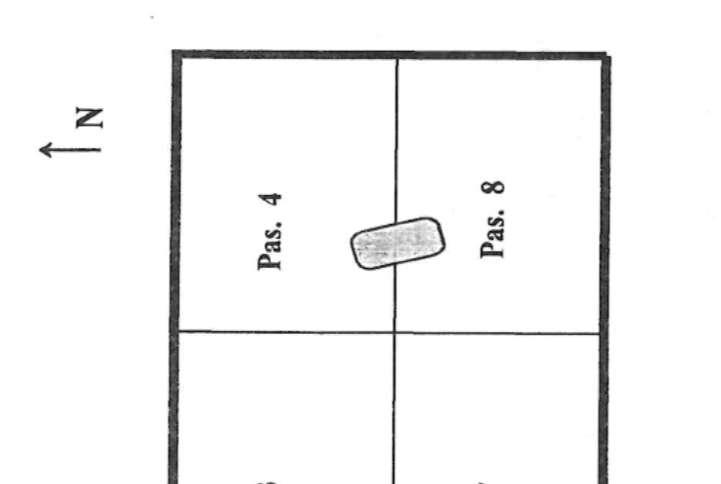
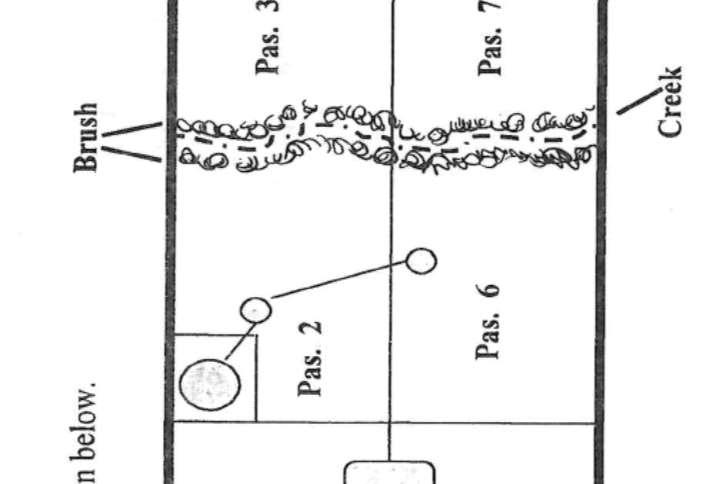
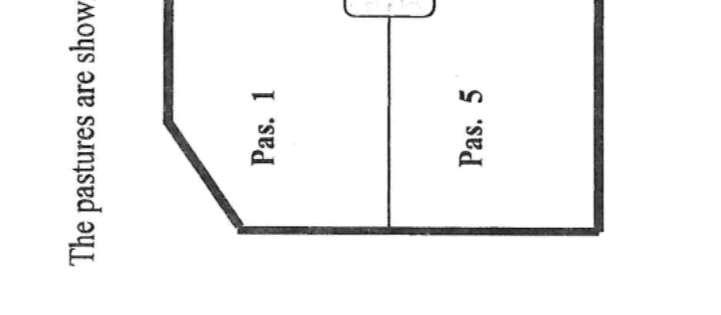


TheBressnerpastureresearchprojectwasdesigned toevaluatethelivestock,agronomicandeconomic impact of two grazing systems. The grazing systems being evaluated are: stock at two acres perhead,grazetoJuly15;andstockatthreeacres perhead,grazetoAugust15.Thispaperevaluates theshortruneconomicimpactofthetwosystems. Thelivestockandagronomicresultsarepresented in other papers in this proceeding (Brazle, pg 16). Thelongruneconomicconsequenceswilldepend onthelongrunagronomiceffectsofthesystems.
The economic impact depends on the gain, the valueofgain,andthecostofgainforeachsystem. Table 1 summarizes the livestock data for the threeyearsthatwasusedinbothsetsofeconomic analysis.
Cost factors for 1990s and 2023 years are shown inTable 2. Grass costs were determined using the Bluestem Pasture reports. Cost and returns are summarizedinTable3forbothyearsofanalysis.
Forthecattlemanwhoownstheland and the cattle, the most pro table system would have been the two acre per steer short season grazingsystem(aka½grazingseason).Thissystem provides the better return per acre. However,
for the cattleman who rents pasture, the most pro table system would have been the three acre per steer mid-season system (ie ¾ grazing season) andrentingadditionalpasturetohandle the same numberofheadastheshortseasonsystem.

Growth promoting steroids in the form of an implant can increase average daily gain by 5% in suckling calves and 14% in stocker cattle (Reinhardt and Thompson, 2016). Implants have been approved for usage since the 1950s. Most approvedimplantsutilizeacarrier thatresults ina biphasic payout pattern of hormone, where there isarapidspikeinbloodhormoneconcentrationsin afewdaysafteradministrationoftheimplantthat slowly dissipates over a period of several months. This pattern is seen when using implants such as Revalor-G(MerckAnimalHealth,Madison,NJ)that utilize cholesterol as their carrier. In the case of Synovex One Grass (Zoetis, Inc., Kalamazoo, WI), a porous polymer coating is used in the implant which extends the payout period of the implant upto200days.
Given the short duration of the grazing period associated with a 90 day intensive early season grazing system and the declining grass quality at the end of the grazing period, implant payout pattern may impact performance response. The objective of the study was to evaluate stocker cattle gains on intensive early double stocked nativetall-grassprairiebetweentwoimplantsthat have different lengths of effective use. The test hypothesis is that a quicker release of hormone from Revalor-G will result in greater gains early in the season, with no difference in gains between implantsoverall.
Stockersteersthatwere71%blackhided(n= 281) were purchased from auctions, vaccinated for respiratorypathogens(Bovi-ShieldGoldOneShot, ZoetisInc.,Kalamazoo,MI)andwormedwithanoral (Valbazen,ZoetisInc.)andaninjectabledewormer (Dectomax, Zoetis Inc.). Steers were weighed individually using electronic scales at the start, mid-point, and end of the 2017 summer grazing period after an overnight shrink on April 24, June

7, and July 24. Steers were randomly assigned to beimplantedwithRevalor-GorSynovexOneGrass and assigned to a pasture with an equal number of calves receivingeach of theimplants withinthe pasture. The number of head in each pasture was different so as to stock appropriately for available biomass. The steers were pastured at the Bressner Research Range Unit near Yates Center, KS. The Bressner Unit was divided into eight individual pastures (approximately 79 acres each), with four pasturesonthenorthsideandfourpasturesonthe southside. PastureswereburnedApril5,2017.
One pasture of calves were removed from the analysis (n = 38) due to inaccurate nal weights as a result of excessive shrink associated with a water tank malfunction within 2days of weighing. WithintheRevalor-Gtreatment,onecalfdiedwhile on pasture and one calf was not weighed on the nal date because he escaped into a neighboring pasture. Therefore, 242 weights were analyzed for the intermediate time point and 241 weights recorded at the end of the study were used in analysis.
No differences (P > 0.05) were observed between Revalor-G and Synovex One Grass for season-long average daily gain and total body weight gain (Table1).Averagedailygainandbodyweightgains werenotdifferent(P>0.05)betweenimplantsfrom the beginning of the trial through the mid-point or from the mid-point until the end of grazing. In addition,steerweightswerenotdifferent(P>0.05) atweighdates(Table1).
The implant cost spread out over gain advantage goes to the Revalor-G treatment. Based on 2017 pricing, the actual purchase price was $1.39 per dose for Revalor-G while Synovex One Grass was $4.95 per dose. Since body weight gains were similarforeachimplanttreatment,thecostofgain waslesswiththeRevalor-Gimplant. Somepayout
likelyremainedontheSynovexOneGrassimplant andcouldbeutilizedpriortomarketingcattle,but isalosstothestockercattleenterprise.




Forage quality affects implant weight gain responses,withhigherqualityforagesprovidinga greater response. As summarized in a stocker calf implant review, other studies in Kansas tall-grass prairie rarely nddifferencesinsteerperformance betweenimplants,butdoresultinincreasedgains above non-implanted (Kuhl, 1997). Nutritional quality of cool season C3 grasses is generally assumed to be greater than warm season C4 grasses as C3 grasses have greater nonstructural carbohydrates and protein with less ber. In a review of the literature, differences in cattle gain basedontypeofimplantoccurredmorefrequently in longer duration grazing studies and in cool seasongrasses.
Steers implanted with Revalor-G or Synovex One Grass performed the same for average daily gain and total body weight gain in an early intensive double-stocked grazing system utilized on native FlintHillspastures.
• Kuhl, G. L. 1997. Stocker cattle responses to implants. ProceedingsImplantSymposium,Stillwater,OK,July.Accessed May 21, 2018. http://beefextension.com/proceedings/ implant_97/97-8.pdf.
• Reinhardt,C.D.,andD.U.Thomson.2016.Growthpromotant implantsinsucklingcalvesandstockercattle:modeofaction, performance response, and practical recommendations. Bov. Pract.50:40-46.doi:10.1016/j.cvfa.2007.03.004.

Thepurposeofthisstudywastodeterminestocker BW gain on patch-burned native tall-grass prairie while also determining plant species in uenced by re. The study was conducted in a split-block experimental design where treatments consisted of a yearly spring burn on the pastures (CON) or patch-burning of 1/3 pasture per yr (PB). Stocker steers grazed the pastures using a three-quarter season (~114 d) grazing period from about midApriltomid-Augustfromtheyrs2006-2012. Steer ADG, nal weight, and total BW gain was not different by treatment (P > 0.35). However, when comparing treatment effects with precipitation classi cation (HIGH, AVE, LOW) cattle on PB had a greater ADG (P = 0.02; 0.10 kg/d), nal weight (P = 0.07, 12 kg), and total BW gain (P = 0.02; 11.8 kg) in LOW precipitation yrs (2011 and 2012). Overall patch-burning provides similar BW gains asyearlyburningonnativetall-grassprairie,while providingaBWgainadvantageinlowprecipitation yrs. Switchgrass (Panicum virgatum) declined (P < 0.05) on CON treatment, while other perennial grasses increased. Annual grasses, including hairy crabgrass (Digitaria sanquinalis) and yellow foxtail (Setaria pumila) increased (P < 0.05) under PB. Botanical composition shifts were similar on patch-burn pastures and full-burn pastures with the exception of increasing annual grasses with patch-burning.
Burning tall-grass prairie is an effective and widely used management tool to improve weight gains and manipulate grazing distribution of cattle on native range. Traditional single re and intensivegrazingsystemsarecommonlyaccepted management practices for cattle producers across the nation, and especially in the Flint Hills (Fuhlendorf and Engle, 2001; Hamilton, 2007). Numerous bene ts have been associated with patch-burn grazing; however the system has been promoted primarily as a method to increase
biodiversity, heterogeneity, and wildlife habitat (Fuhlendorf et al., 2006; Bidwell et al., 2009; NPS, 2009). Patch-burninghasbeentheorizedtomimic the historical patterns of the effects of lightning and the subsequent grazing patterns of American bisonresultinginamanagementunitwithashifting mosaic of grazing distribution (Weir et al., 2007). Since cattle production is a large component of thetall-grassprairieenvironmentitisimportantto quantifycattleperformancewithpatch-burning.
The objectives of this study were to 1. Determine stockerBWgainsonpatch-burnednativetall-grass prairie and 2. Determine plant composition as in uencedby reandgrazing.
Using a split-block experimental design, 2 treatments were implemented and replicated 4 times over 7 yrs (2006-2012). The two treatments consisted of control (CON) pastures which were burned and grazed every yr and patch-burn (PB) pastures which were patch-burned grazed on a 1/3 per yr basis. For the PB pastures each patch in the patch treatment was burned once in every 3-yrcycle. Therefore,ineachPBpasturecattlehad accesstograze1/3ofthepasturethatwasburned within the yr, 1/3 burned the prior yr, and 1/3 that had not been burned for 2 yrs. The pastures on the North side were assigned to the PB treatment and the South side pastures were CON. Dates of burning for all pastures for this experiment were April 13,2006; April 9, 2007; April 9, 2008; April 14, 2009; April 12, 2010; April 12, 2011; and April 2, 2012.

Stocker steers (n = 1495 over 7 yrs; > 90% black hided) were purchased from auctions, vaccinated for respiratory pathogens, implanted, and wormed using commercially available products at each producer’s operation before placement in pastures. Steers were weighed individually using electronic scales. Steers were randomly assigned to treatment using a pre-determined randomized pasture assignment based on order through the chute.
CattleonbothtreatmentswerestockedfrommidApril through mid-August and had free access to the entire area of each pasture along with free choicemineral. This grazingseasonisclassi edas a¾grazingseason(~114-d).Cattleonallpastures were stocked at ~1 head/3 acres and average initial weight was 562 lb. These stocking rates were foratotalof114-dgrazingin2007-2010and 2012; 113-d grazing in 2006; and 118-d grazing in 2011. Stocking rates remained the same every yr to minimize confounding effects on botanical composition due to differences in stocking rates. In 2011, 2 pastures from each treatment were removedfromanalysisbecausepasturetreatment integrity was compromised due to cattle commingling between treatment pastures. There were still 2pastures ofeach treatment includedin analysisfor2011.
In late August through September of each yr one 100-point transect was established in each of the 1/3 portions of the PB pastures and 2 were
established in each of the CON pastures. Each 1/3 of the PB pastures represent a subplot within the pasture. Transects for the CON pastures were located on clay upland range sites. A total of 20 transects were established, 12 in PB pastures and 8inCON.
Steer ADG was not different based on pasture burning method. During the 7 years of the study, there was a wide range of precipitation amounts, thusgainsweredividedintoprecipitationamounts (LOW, AVERAGE,and HIGH). Average precipitation yearswere2006,2009,and2010;Lowprecipitation yearswere2011and2012;Highprecipitationyears were 2007 and 2008. In LOW precipitation yrs steers on PB pastures had a 0.24 lb/d greater ADG (P=0.02,Table1)thansteersonCONpastures. This ADGadvantagetendedtoresultinheavier nalBW (P = 0.07; 26.5 lbs) and increased total BW gain (P = 0.02; 26 lbs) for PB cattle in LOW precipitation yrs. A speculated reason why the PB steers had a greater ADG was biomass availability. A common observation from the droughts in the 1980s and early 2010s is lowered biomass in pasture land (summarized by Kellner and Niyogi, 2014). Even though biomass was not measured in the current study,alogicalconclusionwasbiomassproduction wasalimitingfactorforCONcattleBWgains. Inthe CON pastures the DM availability consisted of the foragethatgrewpost re,whichwasspeculatedto belimitedduetorainfall.

Majorgrassspecieswererelativelystablewithsome year-to-year uctuationonCONpastures(Table2).

Big bluestem tended to decline in 2009 and 2010 comparedto2006(P<0.10),butrecoveredbythe end of the study. Other perennial grasses tended to increase (P < 0.10) in 2010 and 2012 (Table 2) when switchgrass was declining (P < 0.05). Brazle et al. (1999) in a study done at the same location from 1990 to 1998 found that big bluestem, Indiangrass, and switchgrass all increased under a full-burn treatment. Annual grasses, including hairy crabgrass, yellow foxtail, and switchgrass (Panicum capillare) were generally less than 10% of the botanical composition except in 2009, a yr followingawetsummer.
After two PB cycles, botanical composition shifts were similar on PB pastures and CON pastures (Table 3). The only difference was the increase (P < 0.05) in annualgrasses on the PB units. In other studies forbs have increased dramatically within recently burned and grazed patches (Hamilton, 2007).
Big bluestem decreased (P < 0.05) 1-yr post-burn (Table6),butstabilizedthereafter. Littlebluestem and Indiangrass tended to decrease (P < 0.10) the yr of burn compared to the previous yr. Similar
to CON pastures, switchgrass declined over time (P < 0.05) with PB and other perennial grasses increased (P < 0.05) 2-yrs post-burn. Sericea lespedeza (Lespedeza cuneata) decreased (P < 0.05) with the rst burn but increased thereafter under PB. Cummings et al. (2007) found that Sericea lespedeza increased in both patch-burn andfull-burnpastures,buttherateofincreasewas lesswithpatch-burning.
Patch-burning offers a viable option for pasture management in regards to stocker cattle performance. Patch-burning might have added bene ts for cattle producers in yrs where summer drought might occur due to additional residue availableforconsumption,alongwithhighquality burnedpatches. Botanicalcompositionshiftswere similar on patch-burn and full-burn pastures with the exception of increasing annual grasses with patch-burning.




Sericea lespedeza (Lespedeza cuneata; SL) is a high-tannin, invasive forb in the Tallgrass Prairie ecosystem. In Kansas, SL infests 980 square miles of pasture, primarily in the Flint Hills region. SL infestations reduce native grass production by up to 92% through a combination of aggressive growth, proli c reproduction, canopy dominance, and chemical inhibition (allelopathy). Herbicides retardthespreadof SL,butapplicationislaborious and expensive; moreover, herbicides are lethal to ecologically-important, non-target plant species. Increased grazing pressure on SL by domestic herbivoresmayslowitsspreadandfacilitatesome measure of biological control. Unfortunately, mature plants contain high levels of condensed tannins,whichareastrongdeterrenttograzingby beefcattle.Smallruminantshavegreatertolerance for condensed tannins than beef cattle. Sheep, in particular, appear less susceptible to certain plant toxins than beef cattle and may be useful to selectively pressure noxious weeds like SL. The predominant grazing management practice in the Flint Hills region of Kansas involves annual spring burningfollowed by intensive grazing with yearling beef cattle from April to August. During seasonal grazing, 40 to 60% of annual graminoid production is removed and pastures remain idle fortheremainderoftheyear.Underthisprevailing management practice, invasion by SL into the Tallgrass Prairie biome has steadily increased. SL owers and produces seed in late summer from August to September. The absence of grazing pressure during this interval strongly promotes SL seed production, SL seed distribution, and continued SL invasion of the Flint Hills ecoregion. The objective of our study was to evaluate effects of late-season sheep grazing following locally-conventional steer grazing on vigor and reproductivecapabilitiesofSL
seasons from 2013 to 2016 at the Kansas State UniversityBressnerRangeResearchUnitlocatedin WoodsonCounty,Kansas.Nativetallgrasspastures (N = 8; 76.6 ± 8.9) infested with SL (initial basal frequency = 1.4%) were burned annually in early April. Pastures were assigned randomly to one of two treatments: early-season grazing with beef steers(2.7ac/steer;initialBW=568.8±75lb)from April15toJuly15followedbyrestfortheremainder oftheyear(control;STR)orsteergrazingfromApril 15 to July 15 followed by intensive grazing with mature ewes (0.5 ac/ewe; SHP) from August 1 to October 1. Ewes (N = 808 ± 6; initial BW = 143.3 ± 6.8 lb) were assigned randomly to graze 4 of the 8 pastures; remaining pastures were not grazed from August 1 to October 1. Pasture treatment assignmentswere xedforthe4-yrdurationofthe study.

Vegetationresponsestotreatmentweremeasured along four permanent 100-yard transects (100 × 12-in2plotpoints/transect)andintwopermanent 16 × 16-foot grazing exclosures in each pasture (25 × 12-in2 plot points/exclosure). Transect and exclosure data were collected immediately before and immediately after sheep grazing; (canopy type (i.e., grass- or forb-dominated), presence of SL (e.g., yes or no), and evidence of herbivory was noted (i.e., obvious truncation of leaves or stems). A weekly estimate of herbivory was conducted to evaluate grazing pressure on select forb species in each pasture. SL plants, pasture speciescomposition,andsoilcoverwere assessed annuallyeachOctoberusingamodi edstep-point technique. A total of 100 mature SL plants were collected adjacent to permanent line transects in eachpastureimmediatelyafterthe rstkillingfrost (approximately November 1 annually). After SL plants were dried out, seeds were separated and cleaned.Seedweightwasconvertedtoseedcount assuming a density of 770 seeds/gram. Average seed production was calculated by dividing the number of seeds by the number of SL plants in eachsample(n=100).

Pasture forage biomass was not different (P = 0.29) between STR and SHP after steer grazing was halted and before sheep grazing began. Conversely,foragebiomassonrestedpastureswas greater (P = 0.01) than that on SHP at the end of the sheep-grazing period. Herbivory of Sericea lespedeza was not different (P = 0.99) and slight in STR and SHP immediately following the steer grazing period. In contrast, Sericea lespedeza herbivorywasgreater(P≤0.01)inSHPthaninSTR by the end of week 1 of the sheep-grazing period
(10.6% vs. 0.5%); moreover, herbivory of Sericea lespedeza steadily increased (P ≤ 0.01) over time such that 92.1% of Sericea lespedeza plants were grazedinSHPcomparedto1.4%inSTRbyweek8of thesheep-grazingperiod(Table1).Weinterpreted these data to indicate that sheep displayed much greater preference for Sericea lespedeza than steers. Annual seed production by SL and total seedweightwereless(P≤0.01)inSHPthaninSTR (Table 2). We concluded that late-season, intense grazing by sheep may be an effective means for controllingSLinfestation.
We concluded that late season grazing by sheep was consistent with responsible ecosystem stewardship and could be used as part of an integrated weed management plan to control Sericea lespedeza and may add an additional, sustainable incomestreamto anexistingranching enterprise.Beforeimplementingthismanagement strategy, land managers should consider whether additional fencing and predator control may be needed.
Sericea lespedeza (Lespedeza cuneata) is an introduced perennial legume that was rst recognized as a potential weed problem in Southeast Kansas in the early 1980’s. Since that time, sericea has spread profusely throughout southeast Kansas and beyond. Southeast Kansas counties began declaring it a “county option” noxious weed in the late 1980’s; and July 1, 2000, it will be a statewide noxious weedin Kansas.This isthe rsttimethatafederallylistedcrophasbeen declarednoxious.
Sericea lespedeza was introduced into the U.S. by theUSDAin1900forerosioncontrol.Inthe1930’s it was planted on strip mined areas in Southeast Kansas and in the 1940’s and 50’s was planted around State and Federal reservoirs for wildlife habitat.Itisrecognizedforitstoleranceofdrought, acidity and shallow soils of low fertility. It will tolerate soils ranging from very acidic to slightly alkaline, but prefers a ph of 6.0 to 6.5. It does best on clayey and loamy soils that are deep, fertile, and well-drained, but will also grow on poor sites. Sericeauseswaterlessefficientlythanmanyother warm-season plants and does best when ammal precipitationis30inchesormore.
Most recent large scale introductions of the plant occurred with establishing native grass on ConservationReserveProgramacres,aprovisionof the1985FarmBill.NumerousCRP eldsthroughout theeasternpartofKansashavebeenfoundinfested withsericealespedeza.Thenativegrassseedused in these plantings was contaminated with sericea lespedeza seed - not recognized as a noxious or invasiveweedatthattime.
them unavailable for digestion. They also reduce the palatability and digestibility of forages. The level of tannins insericeaappears to increase with maturity of the plant, high air temperatures, and lowrainfall.Thetanninsalsoreduceinsectfeeding.

Sericea lespedeza has been considered valuable for wildlife bene ts, both as food and cover. However, this is not supported by research or practical experience. Deer will not utilize sericea unless it iskept short by mowing or grazing. Quail willconsumetheseedsinfallandearlywinter,but the seeds don’t contain enough energy to sustain quail through adverse weather conditions. Sericea probably holds its greatest wildlife bene t as a source for cover, but when dormant, cover will be lacking because other plants are excluded by the sericea.
Sericea lespedeza, once established, will reduce or eliminate competing vegetation. However, it is relatively slow to establish, having a rather weak and vulnerable seedling stage. On the other hand, itisopportunistic,andwillestablishitselfinfullsun or partial shade. While it tolerates shading quite well, it doesn’t seem to establish in dense shade where direct sunlight does not reach during any partoftheday.
Sericea lespedeza as a legume is recognized for its’ high levels of crude protein, but this is offset by high concentrations of chemical compounds called tannins.Tannins bind withproteins, leaving
Sericeaperhapsestablishesbestwherecompeting vegetationisveryshort,andlightisallowedtoreach the germinating seedlings. Many legumes need good exposure to sunlight during the seedling stage.Thisisthesituationofaburnedpasture.Fire is also assumed to scarify sericea seed, enhancing germination. However, the re may result in more sunlighthittingtheseedandseedlings,resultingin better germination. Seedlings will also germinate and survive where ground cover and other plant competition is quite dense but at a much lower population.Ithasestablishedinfencerows,brushy
andgrassyareas,where reandgrazinghavebeen excludedforyears.
Once established, sericea restricts the amount of light reaching other plants because it is tall with multiple branches and dense foliage. It requires more water to produce foliage than other warm season plants, creating a“drought”for competing vegetation.Italsoproducesallelopathicchemicals that inhibitseedgerminationandgrowthofother plants. Some of these chemicals are produced by the roots, while others come from plant residue, chie yleaves.
Althoughsericeaisalegume,itfurnishesverylittle nitrogen to surrounding plants, and that amount is negated by theeffects of theallelopathic toxins it produces. Rather than providing nitrogen for other plants, it actually makes it necessary to add nitrogen to maintain production of introduced forages.The shoots of grass exposed to the toxins of sericea residue have lower nitrogen content, and overcoming the loss of production caused by thetoxinsrequiresnitrogenfertilization.
As with any weed problem, early detection and treatment is paramount to gaining control of this weed. Investing the time to control scattered plantsandisolatedpatchesmustbedone.Remedy, and Escort are the two chemicals of choice at the present time for controlling sericea lespedeza. Once it becomes established over a wide area, an integrated approach to control will be necessary. Conventional management practices such as prescribed grazing and re have been less than effective in preventing the spread of sericea in rangelands.
Some suppression of sericea has been observed after mowing or burning followed by intensive early stocking with stocker cattle. Livestock will consume the seeds and deposit them elsewhere in manure, so it is advisable to not graze sericea infestedrangeinfallandwinterwhenthe plants have produced seeds. Intensive early stocking provides this option. Goats will provide some control as they do eat sericea much more
readily than cattle. However, any grazing control programmustbecloselymonitoredandcontinued once begun. Grazing will increase the number of tillers of each individual plant. This means that if grazingisceased,thenalargermorerobust,multitilleredplantisleftthanifithadneverbeengrazed and will result in increased seed production. Currentresearchwithgoatsindicatesthattheywill eat sericea and reduce seed production, but have notreducedplantpopulation.
Mowing will reduce the vigor of sericea plants if theyarecutcloselymultipletimeseachyear.Plants should be mowed each time they reach a height of 12-18 inches. The most damaging time to cut sericea is late in the growing season when the plants are trying to build root reserves. However, mowing will not kill sericea, and may damage desirablegrasses.
Sericea lespedeza has increased from just a few plants to a major problem in the Bressner Pasture over the past few years. We have treated several pastures with chemicals with varied results. On Aug.5-9,135goats,59sheepand1llamawereput inthenortheastpastureoftheeasthalfsection.We increasedthefencinginthefollowingmanner:
• West side --- (electric)added 2wires atbottom foratotalof5,2ndwirefromtopisground.
• South side---(electric)added1wireatbottom foratotalof4
• North&East---(barb)addedwirestobringtotal to9,7and5wiresatdifferentsites.Asmallstrip was mowed under the electric fence, to keep fencer hotter and give animals a chance to see fencebeforetheyhitit
Animal management --- Goats were wormed at turnout;mostsheepwerenotwormed.Noweights weretaken.Thellamawasforpredatorcontrol.
Vegetation management --- A small area was mowed on August 4 to see if animals could keep thesmallnewgrowthundercontroltherestofthe summer.Anenclosurecagewasinstalledon
• Aug.12tohelpmonitorthesite.
**Originallyprintedin1998FieldDayReport**



Water is an essential ingredient in the growth of animals. Monitoring the level of water in a tank is necessary for stewardship and producers’level of mentalease. Whenthetanksarenotinthenormal visual path of the workers, checking the tanks regularly is one of these additional chores for the day. When thetanksareadistance away fromthe headquarters,thetravelandtimeareanadditional expense.
Producersneedtoconsiderthetypeofinformation that they wish to know about any tank, how they want to receive the information and value of that information. Technology has made great improvements with the ability to provide current information about the tank level as well as other information about thelivestock inyour pasture(s). Belowisadiscussionofseveraltypesofwaterlevel sensorswehavetried.
If“apictureiswortha1000words”,agamecamera that provides a picture of the tank could be valuable. Manygamecamerastakegreatshots,but thefrequencyandmethodbywhichtheproducer receives the photos is improving. For water level information,the timelinessofthephotobecomes animportantfactor.



Inourdemonstrationweusedagamecamerathat allows us to specify a time period to photograph livestockatthestocktank. Assoonasthecamera takes a photo, it sends the photo to a website via thecellularphonenetwork. Thephotoisstoredto awebsite,allowingtheproducertoviewthephoto oneitheracomputerorcellphone.


In our case, we scheduled the camera to look for livestockatthetanksitebetween1:00and1:30pm and again between 1:30 and 2:00 pm so we had theopportunityfor2photoseachday.Thiscamera system requires motion to activate the camera for a photo and only during our designated times. If a photo was taken, the photo is posted on the
websitewithin5to10minutesofbeingtaken. You may need to re-aim the camera after seeing the initial photos. Consider placing a gauge stick in thetank orheight markson the side of thetank so it is easier to evaluate the level of water in the tankfromthephoto.
In our case, the camera cost about $100, and storageofthepicturesonthewebsiteisFREEifwe storelessthan100/month(2or3photosperday).
The XBASE system through 701x uses a pressure transducer inthe tank to sense the depth of water abovethesensoraswellasthetemperatureofthe water. Everytwohourstheinformationisuploaded to a website by cellular communication. An alert feature allows the producer to specify a minimum water level and maximum temperature. If these parameters are exceeded, a noti cation is sent to one or more cell phones, allowing the producer to takemitigatingactionifdesired.
The system is calibrated during setup by slowly raising the sensor out of the water then lowering the sensor back down so it lies on the bottom of thetank.
The instruction suggests placing the cord to the pressure transducer through a conduit to protect


itfromlivestockdamage.ThexBASEstationshould be fenced out so livestock cannot reach it. The xBASEstationhasasolarpanelonthefronttokeep the batteries recharged and should be installed so itfacessouth.The cellularphone reception should beofreasonablestrengthforthesystemtoperform well.


The701xsystemhasthecapabilitytodomanyother management related tasks. The extra technology within the system may contribute to the cost of theunit. Asweunderstand,theequipmentweare demonstrating would have a cost of about $1,000 withayearlyfeeofabout$72.
TheRanchSensesystemusesapressuretransducer to read thedepth of water above the sensor (from the bottom of the tank). The system proposes to updatethewebsiteaboutevery2hours(depending of the satellite orbit coverage. The system has the abilitytosendatextmessagetoacellphone,ifthe waterleveldropsbelowaproducerspeci edlevel. The information is reported as a percent of tank depth,(76%).
The RanchSense uses the Low Elevation Orbit satellite system to transmit the information from the tank site back to the website to be viewed on

thecomputerwebsiteoracellularphone.
The instruction suggests running the cord to the pressure transducer through a conduit to prevent livestock from messing with the installation. The RanchSensestationshouldbeplacedinaprotected space from livestock. The RanchSense station has a solar panel on the front with the components on the back of the panels. The solar panel front is used to keep the batteries recharged, and should besouthfacing.

The game camera is a simple and straight forward system. The photos can be viewed reasonably soon after the picture is taken, however if the livestock are not there, thecamera maynotrecord a photo for you. It has been suggested that a ag or bannercould be placed within the photo range so the camera will more often see motion even if thelivestockarenotpresent.
Thesystemsthatusethepressuretransducersseem tobeaccurateandtherewasnoreasontoquestion the accuracy of either device. This technology is emerging and the companies are still making improvementstotheirsystemsandaddadditional features. The timeliness of the updates and alerts wasthegreatestconcernwithbothofthesystems. Studyingthedatathatisavailablefromthewebsite showed livestock behavior that we would have missed otherwise. It was easy to see changes in drinking times as the temperatures uctuate. We saw some drinking after midnight a number of times.
One surprise that was not expected to see was a tankthatwashigherbyabout2inchesinthemiddle of the night then went back to normal about 6:30 am. Ithadrainedduringthenight.
For many producers, a photograph of the tank is all they need to see. Other producers will want to receive the noti cation or text to their cell phone and then check the tank level history on the website. These or similar devices will eventually allow producers to make livestock water level monitoringjustanothersimpleandeasychore.

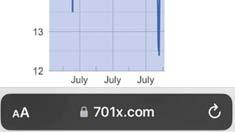
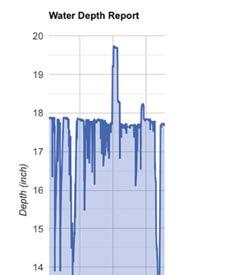

Ponds are common sources of livestock water in Kansas. However, allowing unlimited cattle access to ponds can cause severe bank erosion and poor waterquality.


Cattle prefer clean water and avoid steep, muddy approaches to water sources whenever possible. Developing limited cattle access ramps with a hardenedsurfaceandfencingcangreatlyimprove cattleaccesstowater.

Advantages
• Simpleandinexpensive
• Improves livestock safety and health, (foot rot andleginjuries)
• Reducesbankerosion
• Less sediment and fewer nutrients entering ponds


• Extendspondlifeandimprovedwaterquality
• Appliestoneworexistingponds
• Workswith“Pitponds”andexclusionfences
Limitations
• Fencemaintenancerequired
• Options for location of watering access ramp maybelimited

• FewExamplesinKansas

Slope of the access ramp is important. Ramps as steep as 4:1 have been used, however, a atter slope (8:1 to 12:1) is generally better, especially when conditions are wet or icy. The ramp surface shouldbeabletowithstandheavytraffictoprevent erosion from hoof traffic. A ramp construction method using used tires (called an open bowl tire ramp)isavailablefromauthorsatendofpage.

The width of the access ramp at the shore line should be wide enough to accommodate at least 10% of the herd at one time. The rule of thumb minimum width is 10 feet, plus 1 additional foot for every 10 head of cattle: thus a total width of 20 feet for 100 head of cattle. For cow/calf pairs consider a width of 10 foot, plus 1.5 or even 2
additional feet per 10 pair, making the total width from 25 to 30 feet for 100 pair. Fencing is required to exclude livestock from other parts of the pond anddiscouragecongregatingandloa ngnearthe pond.

Anelectri ed oatingfencemadeofPVCpipeand electric fence wire can be used to restrict cattle movementtothewateringaccessramp.
Extracted from “Water and Water System Handbook”, http://www.ksre.ksu.edu/library/ lvstk2/s147.pdf


• Smallcirclesfordrinking
• Wholetire
• 30.5x32combinetires
• 48x31x20(fronttireonfertilizertrucks)
• Heavy equipment tires that have height available for at least 18 of water above the lowertirebead.
• Half tire (the large mining tires that are cut likeabagel,upto13ft.diameter)
• Tools
• Tirechalk
• Reciprocatingsawwithmetalcuttingblade with5to6tpi(teethperinch)
• Special cleaning and lubricating uid (mixtureofDawndishwatersoap&water)
• Markthedesiredcutlinewithtirechalk
• Cuttireandremovethecenter

• When placing the tank below a pond, it is ideal the site will have at least 6 ft. difference between water level in pond (bottom of the primaryspillwaypipe)andsoillinewherethe bottomofthetankwillset(4ft.minimum)
• Ideallytheover owlinedrainstodaylight
• Ideal to have 1 ½ or 2 inch waterline to and fromthewaterer.
• Ideal to have exible connector or a “swing joint”ontheincominglinesbelowthetank.
• IdealtohaveBrassnipplecomingintotankto connect to oat valve. I do not recommend PVC to come through the concrete and connecttothevalve.
• Plumbintakelinesobottomofthreadsonthe metal pipe is even with top of concrete line (topofbeadinsidethetank).

• Plumb the drain and over ow so the top of thePVCcollarconnectorisinstalledtobejust
ush with the top of the concrete (even with thetopofbeadinsideofthetank).
• Lightly thread a 1 ft. PVC female adapter onto intake line and the drain/over ow. Do this to prevent concrete from getting into the nipple/threads and to maintain as perfectly vertical as possible pipe placement. Do not glue these pieces; they willberemovedwhenconcreteiscured.
sothereare
4 to 6 inches of space left for the concrete. There canbegreaterspace,butitrequiresmoreconcrete.
• Thetankshouldsetonaslightlyelevatedarea.
• Ideal to have geotextile under the tank and gravel to extend the life of the gravel from sinkingintomud


• Firmandtampanygravelbaseundertank.
• Level tank site!!!!. 1 inch out of level is noticeablewhentankisfull.
onto the center of thetirebeadthatwillbeintheconcrete.
• Install a bead of silicone onto the incoming andoutgoinglinesabout2inchesdownfrom thetopofconcreteline.
• An optional 2nd bead of silicone can be installed on the tire bead and on all pipes about 4 inches from the top of the concrete line(topoftirebeadinsidethetank).
• Put silicone on tire bead and pipe(s) immediatelybeforeaddingtheconcrete.
Usinga nger,smearthesiliconebeadsothat itcoversamajorityofthebeadandthepipes.
• Mixtheconcretemixture(with ber).
• The berglass ber is purchased from the ready-mix concrete company. One bag is enough for 1 cu. yd. of concrete (enough for45sacksofpre-mixed80#concretemix). Cost $5 to $7 per bag. Add a small handful persackofpre-mixedconcretemix.
• Placeconcreteintothecenterthroughthetire beadopeningonly.
• Work the concrete under the tire as best as possible. A trowel is useful to make the concretemoveunderthetirewell.Hittingthe tire near the bead with a hammer also helps movethecementunderthetire.
• Make sure the incoming and outgoing pipes arestraight.
• Continue poring concrete until area below the tire is full up to the top of the tire bead. Trowel the area. Can have a ½ inch of crown to the concrete if you desire. Check the level of the threads of the intake pipe and the top of the drain pipe collar to make sure they are atthedesireddepths.
,untilthewatersoftly owsacrosstheconcrete andcoverstheconcretebyatleast2inches.
• Cleanalltools.
• The tank can be lled water, but the more depth placed on the concrete, the better the basemustbetowithstandthepressure.Ifthe basesettleswithinthe rstfewhours,thereis achancethewaterwillleakout.
• Leavetheproject(withtheatleast2inchesof wateronthetopofthefreshconcrete!).

(ideally 1 week or so),installthewaterlevelvalvewith oat.
• Consider the re ll rate of the tank when selecting a valve. Small valves cost less but mayhaveslow oworre llrates.
• Tanks installed using gravity ow from a pond have very lowpressure,selectthevalve accordingly.
• Recommendstainless-steelchainson oats.
• Recommended valve: Watson Manufacturing Inc., Stock Water Control Products, P.O. Box 397,Morrill,NE69358,1-800-292-2987,1-308247-2281. http:// oatvalveusa.com/index.html
• Where possible, install a winter minimum continuous owvalvetohelppreventfreezing alongwithanover owdrainline.
• Setthe oatlevelforthedesiredwaterlevel.
onto the geotextile andupthesidesof thetank,leavingat least1ft.of tank showing above the nished gravel layer. It is besttowaitatleast5daysbeforeusingequipment toputgravelaroundthetank.
Watering livestock in remote locations for the purpose of grazing pasture and forage-based cover crops can be a challenge. In most situations in eastern Kansas, the water source is a pond, a stream or a shallow hand-dug well. The greatest need for water is during the warm months of the grass-growing season. There is also interest in watersystemsthatcantoleratefreezingweather.
This publication describes two systems which use a 100-watt Solar panel with a charge controller. Solar panels connected to a voltage controller and a deep cycle marine-type battery provide the power for the pump systems. Some solar panels are not equipped with a mounting rack. A mounting rack can be constructed from angle iron and 2-inch pipe sothatthesolarpanelscanbemountedonasteel post at 45 degrees in winter or horizontal during thesummermonths.
Producers are encouraged to use the power/load output portion of the charge controller to power the pump rather than connecting directly to the battery. The advantage of this con guration is thatthechargecontrollerwillstopthepumpifthe battery level drops below 10.5 volts. Running the system at lower voltages can damage the battery or pump. Connecting to a battery directly also canrunthebatteryout of charge incasea broken waterlineorover owingtank.
Thepumpisoperatedonthesoilsurfaceabovethe surfacelevelof thewater.Apositivedisplacement SEAFLO Model 55 or similar pump can be used. The system requires a “Deep Cycle” marine-type battery, which is available from most battery supplyoutlets.InatestusingtheSeaFlopump,the deep cycle battery pumped 2400 gallons over 10
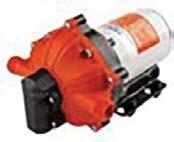
hours,reducingthebatteryfrom12.5voltsto10.75 volts which causes the charge controller to shut thesystemoff.Thepumptestwasconductedwith 6ft.headorlift.Thesystemshouldbepoweredby 1or2-100wattsolarpanels.

TheSEAFLOModel55pumphas an improved pressure switch system,aswellasotherbene ts. Theseinclude:

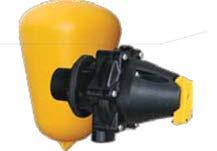

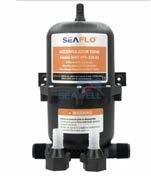
• abilitytopump5galpermin
• built-inpressureshut-offsystem
• abilitytopump100feetinelevation
• ratedforcontinuousduty

• carriesa4-yearwarranty

• uses½inchNPT ttings
Ifatinyleakinahoseorconnection occurs,thepumpwillchatter(come on and off frequently). To combat this, adding an accumulation (pressure) tank will allow some leakage to occur before the pump start/stop/start/stopcycle.
For those producers who want a “plug and pump” system, the SEAFLO 55-Series Water Pump and Accumulator Tank Systemisavailable.This systemhasabuilt-inpressuregaugeandmounting surfaces. A protein tub or other enclosure can be usedtocoverthissystem.
Adding a oat valve to turn the pump on and off completes the system. Hudson, Jobe and Apex valves are examples of oat valves which have a diaphragm shutoff system that causes them to shut-off completely when full leveloccurs.Other oat
systems reduce the ow as the tank approaches full. The Hudson valves work from the surface of the water whereas the Jobe or Apex valves are set inthebottomofthestocktank.
Garden hose and hose connections can be used on these systems, but the intakehosemustbeisrigid enough to avoid vacuum closure during pumping. If garden hose is used as the intake line, heavy duty ¾ inch hose is recommended. An alternative is HDPE(HighdensityPolyethylenePipe)orPVCpipe for the intake. Either type of pipe or garden hose canbeusedforthedischarge(pressure)lines.
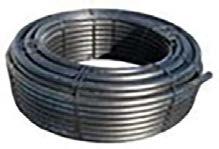
The second pump system is a 12Volt Submersible WaterPump, similar to a submersible sump pump. Thissystemconnectstoadeepcyclebatteryanda 1or2-100-wattsolarpanelwithchargecontroller. This pump is a centrifugal pump with no check valves, and has good ow rate. It is limited to a maximumliftof8meters(26ft.)andhasnoswitch to turn the pump on/off. This system requires an electricalswitchforanautomaticsystem.
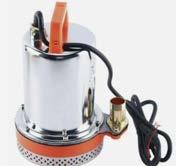
A positive aspect of this pump is the ability to handle more debris, such as algae or dirt in the water, which makes the pump a good choice for pumping from ponds, streams, orshallowwellstonearbycattle. The drain back characteristic of the pump can assist in freeze-proo ng the pump. The electric 2-wire sensor switch is recommended duringwinterfreezingconditions.
The 12-volt systems have a higher amperage draw than the 24-volt systems on other solar pump systems. A relay or continuous duty solenoid is necessary to prevent burning out the lower amperage electrical switches.
An Advanced Systems ALC 1275, switch uses two sensor wires to control the switch and pump. This switchhasan8-secondtimedelaywhenpowering thepumponandoff,soitdoesnotchatter(turnon and off in quick succession) when the wind blows thewaterwavesinthestocktankagainstthesensor wires.This switch is rated for an output of 7 amps; soacontinuousdutysolenoidorswitchrelaymust beusedtopreventelectricalburnout.
A relay switch connected to an electric oat switch will also operate the electric circuit. The oat system may be preferred because there are no probes to clean or adjust. When selecting a relay, select a holder(orpigtail),asshowninthis100Amprelay. Relayscanbepurchasedwithouttheholdersandin various amperages, soselectarelaywithsufficient amperagecapacity.
The Small Stainless electric oat switch has been reliable.Thesmallwiresofthe oatwillcarry1amp thereforearelayorsolenoidisneededtocarrythe amperage load of the pump. A wiring diagram is located at the end of this article. These oats are sensitivetolessthanoneinchwaterlevelandwave actioninatankcansometimescausethepumpto cycle on and off. Therefore, we have begun using timerrelaystoeliminatethecycling,atensec.time delayrelayisourchoice.
A simple system would be the pump wiredtoaTethered(NormallyClosed) oat switch that could be anchored tothesideofthestocktank.
Pumpsystemscanuseaquickconnect, at10or12 Gauge2PinPlug,similartomany4-wheelersprayer systems,andtheplugcanbepurchasedfromalocal automotiverepairshop.Whenpurchasing,request the 10 or 12-gauge wire; whenever possible. Hardwire the system so no connection other than thepumphasaplugtothepowersupply.
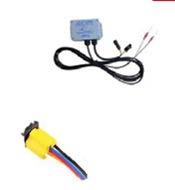

An electronic version of this pump system publication is available at https://www.kcare.kstate.edu/pubs/

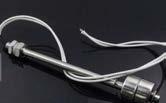
First and most important to remember in spring development – there are no guarantees and no rightorwrongway.

Old history may be the best determining factor in selecting a site. If you can nd someone with the knowledgeofwhatasitedidbackinthe40sor50s, itmaybeyourbestinformationavailable. Ifthatis not available, check out wet spots in the pasture andthegrassspeciesinthewetspots.
Below are some of the steps taken in developing this spring in 1992. Having watched this location forthepasttwoyears,wefeltcertainagoodspring could be found. Running water could usually be found in this location. In 1992 it was extremely wet all spring, but in 1991 it was extremely dry. The backhoe worked a total of 5 hours in digging outthespring,diggingwaterlines,andback lling overthecollectionsite.
probably goofed by not putting a shut-offvalve in thewaterline. Thewaterlinefeedsupthebottom ofthe7-footstocktank. Tanksizeisveryimportant as there must be more holding capacity than the livestock can drink at one time. This pasture is normallystockedat35headofcattle.
Theover owpipemustcarrythewaterfarenough away to avoid mud problems close to the tank. Theendoftheover owpipemustbeprotectedor cattle may plug the over ow pipe and water will spill out around the tank. It was proven this June that after the cattle trample the area it is hard to the ndtheendoftheover owpipe!
Thecattle hadaccess tothisspringand also ranto the creek area. The creek area is very shallow with no hole of water over 3 feet dep. The creek does run year-round and still had good water in 1991 when it was extremely dry. The cattle did appear to drink out of the spring more than they did the creekin1992.
The preliminary hole was 4 feet wide by 11 feet long. The hole was dug to a depth of 4 feet after water was found entering the hole at 2 feet. The bottom and sides of the hole were lined with plastic and then approximately 6 inches of gravel wasputinthebottomofthehole.
Theplasticcollectionpipewas2feetindiameterby 9feetlongwith½inchholesdrilledapproximately every 6 inches all the way around the pipe. The ends of the pipe were covered by a steel plate withapipe ttingononeend. Thecollectionpipe was laid on the gravel and covered with 6 inches of gravel. The gravel was then covered with the plastic and 1 ½ feed to dirt was put over the top, llingtheholebacktogroundlevel.
A two-inch plastic water line was laid from the end of the collection pipe to the water tank. We
Native bluestem pastures are primarily managed for abundant forage production and good livestock performance. But other bene ts from properly managed pastures include clean runoff water, habitat for wildlife, carbon sequestration, and scenic views. Reducing sediment and other impairments in the runoff from the Bressner pasturesisimportantbecauseitcontributestothe drainageareafortheYatesCenterReservoir.
Soil erosion is a natural process and generally not a major concern in pastureland. However, certain activities by cattle and ranchers can accelerate the process resulting in gullies started by ruts that concentratewater ows.Cattletrailing,ranchroads andfeedingduringwetperiodsarehighonthelist ofactivitiesthatsubjecttheprairiesodtoerosion.
Cattle are creatures of habit and commonly“trail” towater,salt/mineralfeeders,andshadewhichcan form paths that lead to gullies. Gullies also start along fences where stocker cattle travel steadily during the rst few days after turnout during the spring. Where small gullies have started along fences,cattlepaths,andpastureroads,
. Annual grasses and weeds will soon establish and eventually be replaced by native species. Larger gullies often require structuresmadeofrockorearthen lldesignedby anengineertobefullyeffective.
Pasture roads can also lead to gullies as repeated vehicle traffic, especially during wet times and on steeper slopes, breaks the sod cover and forms ruts. Negative whenever possible. Use lightweight vehicles with broad tires suchasATVsandUTVsifavailableandtasksuitable.
Winterfeedingsitesareanothersourceofsediment, minerals and bacteria in runoff. willaltertrafficpatterns, reduce spot damage to the sod, and encourage cattle to consume dormant forage in lightly used areas of the pasture. while saving sheltered spots for extreme conditions. Feeding supplements in larger amounts just 2-3 timesperweekwillalsoreducevehicletraffic.
Where cattle trail along fences, , especially on steeper slopes. Even those unwanted osage orange trees can be cut and placed to direct cattle traffic. At turnout time for stockers,

What about healing actively eroding gullies? The key is to slow the owing water in the channel if it cannot be diverted away. Starting at the upper end of smaller gullies (often a headcut),
Spring burns that remove both the standing dead material and the surface layer of mulch leave the soil vulnerable to sheet and rill erosion until new plant growth is sufficient to provide protection. Whenever possible, in order to leave a protective layer on the soil surface. In the patch bum-patch graze system, the higher rates of sheet and rill erosion than may occur in the heavily grazed third of the pasture are likely offset by greaterprotectionintheremainingtwo-thirds.
Rememberthatmaintaininggoodgrassandmulch coverwill slowrunoff,trapsedimentsandincrease in ltration, thus, in reducing soil erosion in pastures. is to minimize livestock and humanactivitiesthatleadtoconcentrated owsof runoff.And,YES,runoffrainswillcomeagain.

Somelivestockproducersare ndingpracticaluses fordronesthathavesimpleonboardcameras.Uses include nding missing animals, checking fences and water, and visualizing the extent of problem brush species. The potential certainly exists for ranchers to make pasture management decisions aidedbyinformationgatheredusingdrones.
Adecentonboardcameracanbeusedtoproduce highly detailed pasture aerial maps. These can be used for making accurate measurements and for monitoring change in pasture vegetation. The process of making such pasture maps from a mosaic of GPS-labeled photos is complex, but the availability of free mappingandanalysis tools, along with reasonably priced online services is helpful.Athree-dimensionalmodelofthepasture and its vegetation is an intermediate product of pasture aerial photo production. Forage biomass canbeestimatedfromathree-dimensionalmodel of pasture forage (Merwe et al., 2020) Pasture biomass estimates can help managers set and adjuststockingrates.
A series of basic individual drone images which cover a representative area of a pasture can also aid in making pasture management decisions. SamplePoint is a well-tested free photo analysis tool that systematically samples individual pixels of photos, aiding the user in identifying percent cover (Booth et al., 2006). Photos from a lowaltitude drone transect ight over a grazed cover crop eld were analyzed using SamplePoint to demonstrate how percent ground cover can be used to schedule livestock removal. Similarly, SampleFreqaidstheuserindeterminingpresence or absence of species of interest within areas of pre-determined sizes (Cox et al., 2021). Photos systematically selected from a pasture mapping drone mission where analyzed to demonstrate how to establish a monitoring baseline for woody plantspeciesinapasture.




• Booth, D. T., Cox, S. E., & Berryman, R. D. (2006). Point Sampling Digital Imagery with ‘Samplepoint.’ Environmental Monitoring and Assessment, 123(1–3), 97–108. https://doi. org/10.1007/s10661-005-9164-7
• Cox, S. E., Booth, D. T., & Berryman, R. D. (2021). Measuring nested frequency of plants from digital images with SampleFreq. Ecological Indicators, 121, 106946. https://doi. org/10.1016/j.ecolind.2020.106946
• Merwe, D. van der, Baldwin, C. E., Boyer, W. (2020). An efficient method for estimating dormant season grass biomass in tallgrass prairie from ultra-high spatial resolution aerial imaging produced with small unmanned aircraft systems. International Journal of Wildland Fire, 29(8), 696–701. https://doi. org/10.1071/WF19026
Thisgraphiciscreatedbycombiningdroneimagesofacow toestimateitsvolumeandweight(ResearchbeingconductedatColoradoStateandUniversityofKentucky).




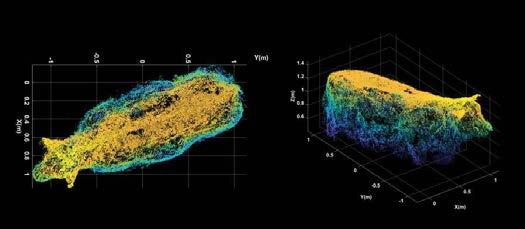







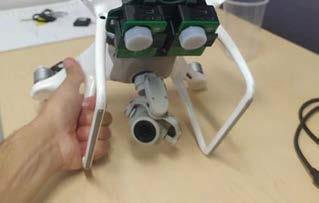
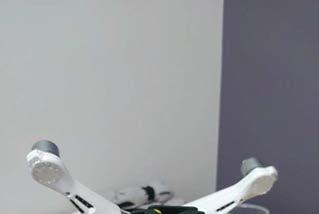 Photo credit: Hoagg, Jackson/Sama/Yang, printed in bbc.com
Photo credit: Hoagg, Jackson/Sama/Yang, printed in bbc.com

K-State Research & Extension weather stations are at the root of the Kansas Mesonet. These stationswere establishedin 1986 at KSRE research centers and experiment facilities around the state. Most were co-located with National Weather Service Cooperative Observing Stations. Since that period our network has grown and we now collaboratewiththeKansasWaterOffice,BigBend Groundwater Management District, the Equus Beds Groundwater Management District, and the USDASoilClimateAnalysisNetwork.
Stationsarelocatedinlong-termsiteswithexposure as recommended by the World Meteorological Organization. New locations are selected based on unavailability of automated weather data in theregion.Mostof thesitesarelocated onprivate land with permission of the cooperating land owner (Figure 1). All weather stationsuse research gradeinstruments which are installed at theWMO
recommendedstandardheights.Selectedweather stations have a second wind monitor at the 10m height(Figure2).
Technicians from the Kansas State University Weather Data Library regularly visit each station a minimum of two times each year. Once during the Spring and again in the Fall. During these site visits sensor, data logger, communications, and power supply systems are inspected to ensure they are functioning according to Kansas Mesonet operation standards. When a sensor is not functioning properly it is replaced with a new one and returned to the manufacturer for repair and recalibration or recycled as electronic waste. During each visit the overall site conditions ( e.g. fencing, immediate area grass cover, surrounding fetch areas ) are inspected to ensure accurate and representativemeasurements.
AnimalComfortIndexAirtemperatureisadjustedforairrelativehumidity, windspeed,andincidentsolarradiationusingthe comprehensiveclimateindextogenerateanindexof animalcomfort

Growingdegreesforcorn andgrainsorghum
Measureoftheaccumulationoftemperatureunitsover acropspeci cupperandlowertemperaturethreshold forpredictingthegrowthanddevelopmentofcornand grainsorghum
ReferenceevapotranspirationEvapotranspirationfromahypotheticalgrassandalfalfa referencecrop12-cmheightwithoptimalsoilmoisture conditionsandnonnutritionalorpest-relatedlimitations
Heatindex
Windchill
Apparenthottemperaturetothehumanbodyastheresult ofthecombinedeffectofhighairtemperatureandair relativehumidity
Apparentcoldtemperaturetothehumanbodyastheresult ofthecombinedeffectoflowairtemperatureandwind speed
TemperatureinversionsDifferenceoftheairtemperaturebetween1.5-and 10-mheight.Aninversionisproducedwhentheair temperatureat10misgreaterthantheairtemperature at2-mheight
Relativesaturation
Representsthefractionofvolumetricwatercontentrelative tothemaxvolumetricsoilwatercontentatsaturation
Airtemperature,relativehumidity, windspeed,andsolarradiation

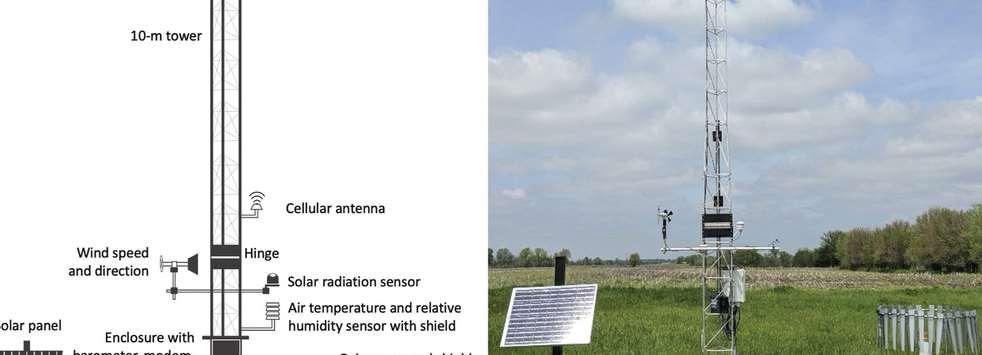
Airtemperature
Airtemperature,airrelative humidity,windspeed,and incidentsolarradiation
Airtemperatureandairrelative humidity
Airtemperatureandwindspeed
Airtemperatureat2-and10-m height
Volumetricwatercontentat5-, 10-,20-,and50-cmdepth

Mader and co-workers at the University of Nebraska developed the Comprehensive Comfort Index to incorporate both extremes of hot and cold into one index value. It is unique in that it includes,inadditiontoairtemperatureandrelative humidity,effectsofwindspeedandsolarradiation. Development and validation of the index used datafrombeefanddairycattle.


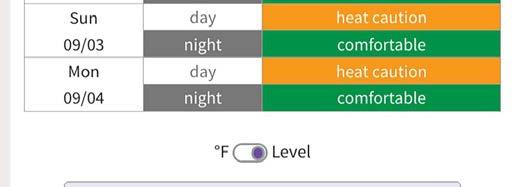





Actual animal response to temperature stress will be dependent on a number of factors not accountedforintheindex.Thoseinclude,butaren’t limitedto,age,haircoat(wintervssummer;wetvs dry), health, body condition, micro-environment andacclimatization.


The Kansas Mesonet provides a 7-day forecast animal comfort index. This utilizes the equation found on the previous current condition page (Whichisstillavailable)andtakesintoconsideration the National Weather Service 7-day forecast. This provides decision makers the ability to see in the future and for potential periods of both heat and cold extremes. The intent is to provide as much advanced notice so that decision makers can take proactivemeasurestomitigateloss.

